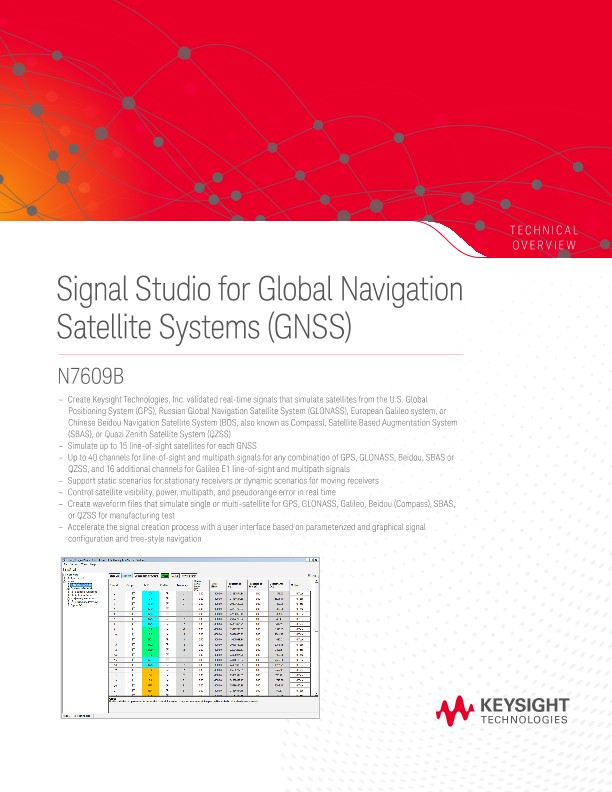
Signal Studio for Global Navigation Satellite Systems (GNSS) N7609B
Technical Overviews
N7609B
- Create Keysight Technologies, Inc. validated real-time signals that simulate satellites from the U.S. Global Positioning System (GPS), Russian Global Navigation Satellite System (GLONASS), European Galileo system, or Chinese Beidou Navigation Satellite System (BDS, also known as Compass), Satellite Based Augmentation System (SBAS), or Quazi Zenith Satellite System (QZSS)
- Simulate up to 15 line-of-sight satellites for each GNSS
- Up to 40 channels for line-of-sight and multipath signals for any combination of GPS, GLONASS, Beidou, SBAS or QZSS, and 16 additional channels for Galileo E1 line-of-sight and multipath signals
- Support static scenarios for stationary receivers or dynamic scenarios for moving receivers
- Control satellite visibility, power, multipath, and pseudorange error in real time
- Create waveform files that simulate single or multi-satellite for GPS, GLONASS, Galileo, Beidou (Compass), SBAS, or QZSS for manufacturing test
- Accelerate the signal creation process with a user interface based on parameterized and graphical signal configuration and tree-style navigation
Simplify Global Navigation Satellite System (GNSS) Signal Creation
Keysight Signal Studio software is a flexible suite of signal-creation tools that will reduce the time you spend on signal simulation. For GNSS, including GPS, GLONASS, Galileo, Beidou and SBAS/QZSS, Signal Studio’s performance-optimized signals—validated by Keysight—enhance the characterization and verification of your devices. Through its application-specific user-interface you’ll create standards-based and custom test signals for receiver test.
Component and transmitter test
Using live off-the-air satellite signals for GNSS receiver verification is unreliable because of the high variability and non-repeatability of these signals. N7609B Signal Studio’s advanced capabilities enable you to create signals that simulate satellites in the GPS, GLONASS, Galileo, or Beidou constellations for testing GNSS receivers in an accurate and repeatable manner. The application simulates multiple signals from many different satellites, with different time delays, Doppler shifts, and power levels. The N7609B software also has the capability to create and transmit impairments such as multipath signals, loss of satellite visibility, and ionospheric and tropospheric atmospheric attenuation, and can also add calibrated AWGN. The ability to add these impairments allows the N7609B to provide a complete suite of signals for full verification of GNSS receivers. Applications include:
- Performance verification and functional test of receivers, during RF/baseband integration and system verification
- Coding verification of baseband subsystems, including FPGAs, ASICs, and DSPs
The N7609B software’s advanced capabilities operate in real-time mode, which is used to define the parameters of nonrepeating and dynamically changing signals needed for receiver testing. Its graphical interface provides a direct instrument connection for parameter transfer and interactive control during signal generation.
For receiver testing in production or simple receiver testing in R&D, the N7609B also offers a basic capability that uses waveform playback mode to generate signals. The waveform files simulate a single static satellite with fixed Doppler shift. These signals can be used to test receiver sensitivity, acquisition, and tracking. Single or multi-satellite satellite waveforms can be created for GPS, GLONASS, Galileo, Beidou (Compass), satellite-based augmentation systems (SBAS), or the Japanese Quazi-Zenith Satellite System (QZSS).
Apply your signals in real-world testing
Once you have setup your signals in Signal Studio, you can download them to a variety of Keysight instruments. Signal Studio software complements these platforms by providing a cost-effective way to tailor them to your test needs in design, development and production test.
For real-time signal generation with advanced capability options:
- X-series vector signal generators: N5182B MXG and N5172B EXG
- PXB baseband generator and channel emulator
For waveform playback using the basic capability option:
- Vector signal generators
- X-series N5182B MXG and N5172B EXG
- First-generation N5182A MXG
- ESG
- PSG
- M9381A PXIe VSG
- EXT, E6630A, and E6640A wireless test set
- PXB baseband generator and channel emulator